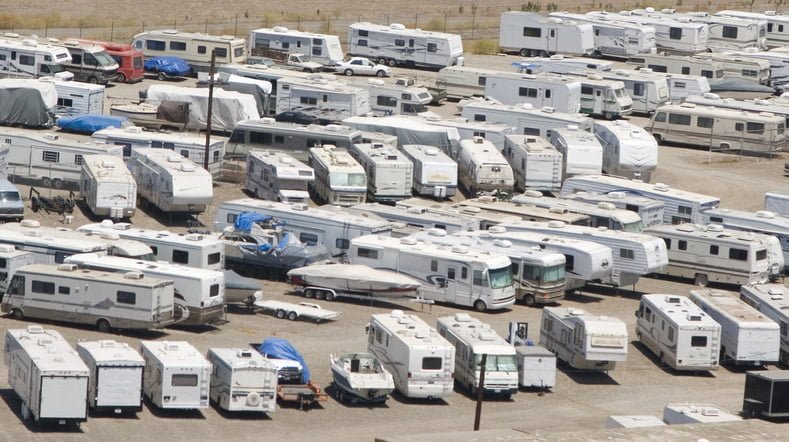Since RVs are typically not used as frequently as your everyday vehicle, they require extra stringent tire maintenance.
Scroll down for some tips that will help you minimize your chances of a tire blowout when driving your RV.
Make Sure Your Tires are Fully Inflated Before Departing on a Trip
Proper tire inflation is key for maintaining good tire tread and avoiding tire blowouts.
Under-inflated tires cause more pressure to be put on the sidewall of the tire. Since sidewalls are less elastic than the actual treads (the part of the tire that is in direct contact with the road), they won’t support the added pressure caused by under-inflation. Consequently, this can cause the seal to break away from the wheel resulting in a tire blowout.
Overinflation may not cause tire blowouts, but it is equally as dangerous as underinflation because it can lead to less traction and control of your vehicle. Overinflated tires are also more susceptible to punctures from sharp objects.
Always check your tire pressure before setting off on the road in your RV. Most gas stations have tire fill stations where you can fill your tires to the correct PSI. Consult your vehicle’s manual for a recommended PSI when inflating your RV tires.
This tire pressure advice might seem overkill, but if you are planning on driving on uneven terrains, the correct tire pressure can greatly reduce the risk of tire blowouts. It can also improve your RV’s fuel economy.
Always keep a tire pressure gauge on road trips, and check tire pressure every 1,000 miles travelled.
Don’t Overload Your RV
RVs and trailers have a weight limit, and if you exceed the limit you increase your chances of causing a tire blowout or broken axle.
Look for the Gross Combination Weight Rating(GCWR) for your specific RV. This GCWR rating is the maximum weight that your RV can handle once everything (and everyone) is inside.
A good place to check your GCWR is at commercial truck weigh stations which can be found dotted along the sides of highways.
Search for a weigh station close to you when planning trips, and go there on the day before your trip with everything you plan on taking for a quick weigh-in (just to be safe) before you depart. If your RV is over its weight rating, then you may have to remove some items for a safer journey.
Know the Terrain You Will Be Travelling On, and Use The Right Tires for the Job
Choosing the right tires for your terrain will greatly reduce your chances of having a blowout or punctured tire during your RV trip.
Here are some tips for choosing the best tires for your RV:
- If you are travelling long distances at highway speeds, you may want to consider using low rolling resistance tires because they generate less heat (hot tires can cause tire blowouts).
- If you are constantly travelling on grass or gravel, you should consider buying tires with a 10-ply rating. 10-ply tires have 10 layers and are less likely to suffer punctures from shop rocks and other debris. 10-ply tires aren’t the best option for freeway driving, however, so you might want to have two sets of tires to cover all fronts.
- All-terrain tires are the best option if you drive both on and offroad. Just remember to take a break every couple of hours when driving at high speeds to let the tires cool down.
It’s important to deflate your tires 4-8 PSI under specification when driving offroad to avoid tire punctures and improve traction.
Store Your RV Correctly to Prevent Dry Rotting in Tires
There are many different ways to store RV tires to prevent dry rotting. The ideal environment for storing your RV is in a cool, dry area.
Since tires are designed to be used regularly, they can dry out and weaken when sitting over time.
Ideally, you should store your RV indoors for maximum protection. If you have to store your RV outside, you might consider buying a large opaque covering to help shield it’s tires from direct sunlight and rainwater.
When pulling your RV out of storage, it’s important to inspect the sidewalls of the tires for dry rot. Here are some signs of dry rot to keep an eye out for:
- Cracking in the sidewalls of the tires
- The tire is brittle and dry to the touch
- The tire has a grey, faded colour on its exterior
Take your RV to your nearest tire shop/tire specialist if you see any of these signs of deterioration when inspecting your tires.
Avoid using purpose tire cleaners on RV tires because they are designed for tires with regular use. Tire cleaners can dry out the rubber on tires that aren’t used frequently. Instead, it’s better to clean your tires with some warm water and dishwasher detergent.
Replace Tires Over Six Years Old
Tires older than six years old will likely have irreversible decay whether or not they are being ridden.
Driving on tires over six years old is not recommended because of the loss of elasticity and moisture. Old tires are increasingly susceptible to blowouts and should be replaced for the safe operation of your RV.
You can check the age of your tire by looking on the sidewall at the final two digits indicating the year the tire was manufactured. For example, if the last two digits are 19, then that means the tires were manufactured in 2019.
If possible, you should replace your RV tires with the exact brand and size that were previously installed. If you can’t find the exact replacement tires, make sure to buy as close to the same size as possible.
Talk to a local tire shop to help assist you in buying and installing the correct tires for your RV.




